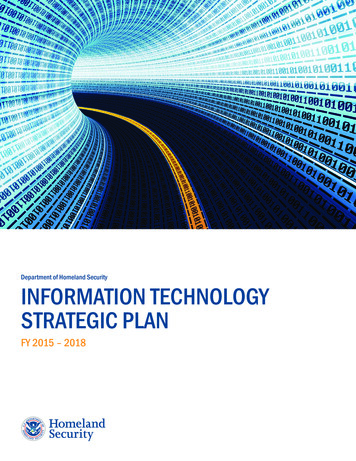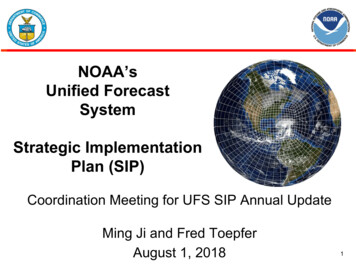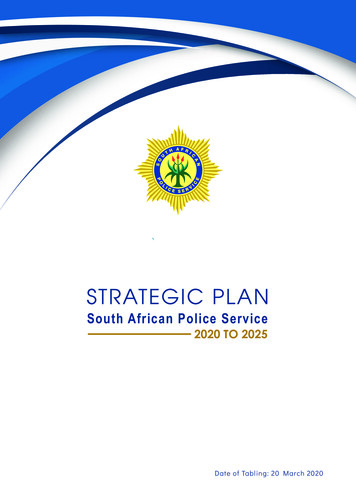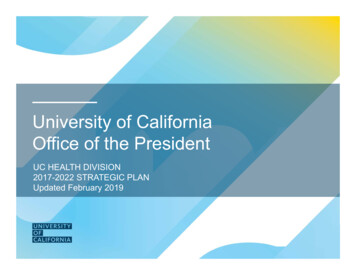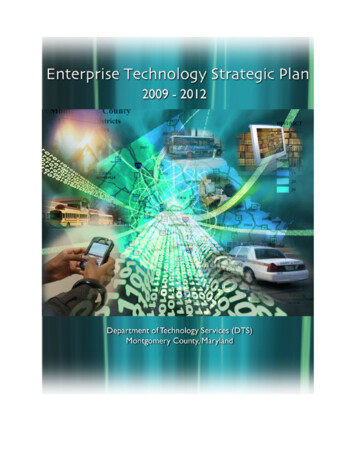
Transcription
Message from the DirectorMontgomery County Government (MCG) has made significant advances through itsembrace of technology solutions that improve business response to its customers as well asstreamlining the internal business processes. To continue a positive contribution from ourinvestment in Information Technology (IT) solutions and innovations, it is essential forMontgomery County Department of Technology Services (DTS) to articulate theinterpretation of Executive guidance as well as business mission objectives to confirm itsunderstanding and prepare for future technology choices.The purpose of this Enterprise Technology Strategic Plan (ETSP) is to describe anddocument DTS s interpretation of the direction of technical issues and to set the baseline forhow information technology solutions are approached. While the ETSP is a point-in-timeassessment of current processes and methods, it illustrates both the significantachievements and streamlining from previous efforts as well as sets a definitive road mapfor new objectives and methods.This is a living document that can and will be reviewed on a periodic basis both internallyas well as through the MCG Executive Leadership to ensure that it continues to support theEnterprise Business mission and strategies. The use of the ETSP to guide our InformationTechnology investments and activities will maintain a sustainable alignment between ourcorporate mission and technology improvement expectations.E. Steven EmanuelDirectorDepartment of Technology Services2
Table of Contents123456789Introduction .5Mission .72.1County Business Mission Objectives.72.2Technology Mission.8Vision .9Focus on Enterprise .174.1Developing the Business Strategy.184.2Application Strategy.224.3Operations and Infrastructure Management Strategies.274.4Enterprise Architecture .404.5Project Management .444.6Information Security.47Innovation.535.1Existing Technology Strategies .535.1.1 Virtualization .545.1.2 Open source (infrastructure).565.1.3 Open Source Software Solutions.575.1.4 Open standards (i.e., LDAP, XML, J2EE, etc.).585.1.5 Environmental (green) .595.1.6 Voice over IP .605.1.7 Web 2.0 Strategies .615.1.8 Collaboration.675.1.9 Heartbeat performance monitoring .685.1.10Enterprise Architecture Quarterly Assessment.705.2Existing Business Strategies .715.2.1 Self Service.715.2.2 Partnerships.725.2.3 Architectural Proof of Concept.73Governance.756.1Technical Operations Management Group (TOMG).776.2Information Technology Policy Advisory Committee (IPAC).796.3ITPCC Overview.80Resources and People.857.1Retention / Attraction .85Next Steps.898.1Business Assessment and Strategic Alignment .898.2Long Term Programs.93Appendix 1 Acronym List .1113
Table of FiguresFigure 1 - DTS ETSP Approach .10Figure 2 - Technology Support Organization .15Figure 3 - ITPCC .20Figure 4 - DTS Operation Strategic Initiatives.28Figure 5 - IT Security Program Implementation Cycle .34Figure 6 - PBX Architecture.36Figure 7 - Raw Aggregate Backbone Bandwidth .39Figure 8 - Information Technology Framework .42Figure 9 - Main Deliverables of the Project Management Process .44Figure 10 - Enterprise IT Value Proposition .46Figure 11 - Application Portfolio Management .46Figure 12 - Project Portfolio Management.47Figure 13 - Staff Completion of Security Awareness Training.49Figure 14 - Sample Web Filtering Report.50Figure 15 - Sample Vulnerability Scan Report .50Figure 16 - Information Risk Solutions of Current Montgomery County Pressures.51Figure 17 - Server Virtualization.55Figure 18 - Server Virtualization Rate .56Figure 19 - Currently employed open source software .56Figure 20 - County s supported standards and protocols.58Figure 21 - Enterprise Service Bus (ESB).59Figure 22 - MyMontgomery Home Page .63Figure 23 County RSS Feeds .64Figure 24 - County Blogs.65Figure 25 - Montgomery On Demand.66Figure 26 - County Podcasts.67Figure 27 - Physical topology of the HEARTBEAT infrastructure .69Figure 28 - Logical view of the Heartbeat Infrastructure .70Figure 29 - APOC Phases.74Figure 30 - Governance Input .76Figure 31 - TOMG Framework .78Figure 32 - Enterprise Governance Structure .82Figure 33 - EA Governance Structure .83Figure 34 - Workforce Generation Mix .87Figure 35 - Building Block Process for Balanced Scorecard and Strategic Mapping.914
1IntroductionThe Department of Technology Services (DTS) of Montgomery County is a fully integratedInformation Technology Business Unit in which all County government departments andoffices have access to information within a secure environment to perform governmentservices. Due to de-centralization of the County government, however, each department orbusiness unit was given the option to have an individual Information Technology Services(ITS) work unit with dedicated staff to address their independent and respective IT needs.The most recent version of the Montgomery County Information Technology Strategic Plan(ITSP), (2006 2007) provides an overview of the current status of information technologyservices provided by DTS. This new Enterprise Technology Strategic Plan (ETSP), (20092012), will be an enterprise wide ITS initiative. The goal of this strategic plan is to driveMontgomery County s technology service solutions and business needs for departmentsthrough an enterprise process and create collaborative efforts through a centralizedprocess, facilitated by the DTS.Due to the of rapid advancements of information technology capabilities, the impact thatinformation technology is having on today s business environment and the need for thebusiness to strategize on technology choices, Montgomery County has recognized the needto assess its use of information technology. The assessment will allow MCG to better5
manage its information technology inventory, technology costs, and to manage its businesswith a definitive IT direction and long-term strategy.As of September 2006, the Information Technology Strategic Plan (ITSP) set the directionfor DTS by looking at the business demand, selecting and documenting the strategicdirection, and determining how limited resources (primarily funding and personnel) canachieve the plan. This current plan ETSP will outline a future oriented technology programthat directly supports Montgomery County s missions, goals and objectives. Additionally, theETSP will tactically and strategically guide Montgomery County Government (MCG) to amore proactive enterprise approach to implement and manage IT solutions that willprovide a more global benefit to Montgomery County as a whole.This Strategic Plan is a living document meaning as we progress and reach our goals theplan will be updated accordingly. It represents MCG s current statement of direction ontechnology issues and should be used as a starting point for all new IT acquisitions ordevelopment projects. As the standard for IT services is established through a governanceprocess, the approach enables the DTS to define, develop and maintain a portfolio oftechnology solutions that can be effectively supported to meet business expectations, giventhe availability of human and fiscal resources.Through continuous input from the business units, ongoing data collection, and regularreport card updates, this Enterprise Technology Strategic Plan will remain current. MCGwill continue to use this document as a motivating factor to strategically move forward.Why an Enterprise Technology Strategic Plan?From inception, MCG has transformed the way it serves its citizens. This ETSP transitionsour current methods to a comprehensive themed business approach. This is intended todemonstrate the partnership between all of Montgomery County s Business Units and DTS,with the ultimate goal being to improve customer service delivery through overall strategicforward thinking.6
22.1MissionCounty Business Mission ObjectivesThe Department of Technology Services (DTS) must direct its efforts toward the satisfactionof Montgomery County Government (MCG) County Executive s Mission Statement. Thepurpose of the Enterprise Technology Strategic Plan is to provide a means of responding toboth business and technical direction by focusing on the internal efforts of DTS, and byaligning both DTS and departmental IT resources and long term implementation initiativeswith the Mission of the County Executive. With this mission in mind, ETSP goals will bedeclared to ensure that Countywide Technology Support is aligned with the CountyExecutive s Mission.County Executive s Mission StatementWE pursue the common good by working for and with Montgomery County s diversecommunity members to provide:A Responsive and Accountable County GovernmentAffordable Housing in an Inclusive CommunityAn Effective and Efficient Transportation NetworkChildren Prepared to Live and Learn7
Healthy and Sustainable CommunitiesSafe Streets and Secure NeighborhoodsA Strong and Vibrant EconomyVital Living for All of Our ResidentsAS dedicated public servants, the employees of the Montgomery CountyGovernment strive to embody in our work these essential tenceInnovationRespect for the IndividualFiscal PrudenceIntegrityTransparencyTechnology MissionMontgomery County will utilize IT to:Enable our employees to provide quality services to our citizens and businessesDeliver information and services to community residentsIncrease the productivity of government and citizensBackgroundAn Information Technology Strategic Plan is a road map. It represents MCG's currentstatement of direction on information technology issues and is used as a starting point for allIT acquisitions and IT development projects.The Enterprise Technology Strategic Plan (ETSP) is intended to present the collectiveenterprise s statement of policy toward IT, the IT organizations vision, directionalstatements and broad decision guidelines. It provides the guidelines through which ITprojects are selected, planned, executed, and measured. MCG s technology and businessleadership must further develop a plan for the adoption of enterprise technologyarchitecture. DTS must continuously review and revise business and technology details inorder to implement the strategic initiatives outlined in this ETSP.The ETSP is a living document, which will be reviewed at least once per year and updatedin conjunction with the MCG s Mission and Business Strategy. Each version of theTechnology Strategic Plan will be distributed widely so that it may be effectively used as aplanning and communication tool.Some specific uses for this Enterprise Technology Strategic Plan include the following:Describe the opportunities and benefits for leveraging common technologyinvestmentDescribe support operation services implications for technologyProvide a framework for cost containment and cost reduction activitiesProvide support for tactical (0 2 years) decisionsBuild a direction for strategic (2 5 years) decisions8
3VisionThis Enterprise Technology Strategic Plan(ETSP) was developed through a globalpartnership, commencing with concurrence from the IT Policy Advisory Committee (IPAC)with key internal Department of Technology Services (DTS )staff and external supportservices, following an industry standard strategic planning model. The DTS team wasresponsible for shaping the enterprise theming model and identifying/validating thedepartmental and common IT direction, principles, goals and objectives as a part of thecountywide partnership.DTS began by assessing the current state of IT within Montgomery County Government(MCG). This assessment will continue to be validated through an ongoing, establishedmethodology that includes data collection, analysis and discussions with key MCG and DTSstakeholders. These steps are an important part of the development, planning andvalidation process to facilitate the assessment of the current state of IT requirements,perceptions, applications and provider organizations.Key input to the plan includes the following:Presentation and feedback from IPAC on the concept of the Enterprise TechnologyStrategy planInitial interviews with County Department Directors and LeadersGroup interviews with Directors and DTS staff as a part of the theming constructWorkshops with DTS management and program management staff9
Montgomery County Council ObjectivesFY 2006 2008 Montgomery County DTS Technology Strategic PlanDTS-specific documentationThe following figure depicts a nationally recognized strategic planning approach, whichplaces an emphasis on business-driven planning for technology decision making at anenterprise level.Figure 1 - DTS ETSP ApproachBusiness sTechnologyThis plan builds upon the successes and strengths of MCG in deploying and utilizingtechnology in support of its operations. The ETSP also builds on the accomplishments andcurrent strategies MCG has made in exploiting IT to further the objectives of providingservices to its local businesses and citizens, notably:Alignment of business objectives and direction for DTSThere is an emerging governance structure that includes participation from businessleaders and managers in the early phases of the IT investment life cycle. There ishigh-level sponsorship and involvement from the business for transformationaltechnology initiatives (e.g., Enterprise Systems, project and program processes,organization alignment supporting technology partnership).Execution of various initiatives aimed at improving the overall planning andmanagement of technologyDTS established a major initiative steering committee inclusive of technologyleadership input, in concurrence with the development of an ETSP that articulates aunified and clear mission, vision and objectives. The ETSP also bonds the optionsfor attaining those objectives, and sets the road map for attaining them. DTSestablished an enterprise Project Management Office (PMO) as an enabler toaddress business needs and provide necessary tools and processes to manageprojects efficiently and effectively. As well DTS leveraged outsourcing.Dedicated departmental technology staffMany of the larger departments within the County have staff that support existingtechnology solutions. Most departmental teams have alliances with DTS and10
support standards, processes and rules that support a consistent approach totechnology selection, delivery and support.Dedicated DTS staffMany DTS personnel have long tenure and have comprehensive understanding ofthe business, mission and processes of MCG.Use of technologies to transform the businessThe plan for the implementation of an Enterprise Resource Planning (ERP) solutionas well as a consolidated call center Constituent Relationship Management (CRM)have illustrated a willingness to change existing business processes and adopt bestpractices. MCG has consistently shown its desire to be a leader in proactiveapproaches as a government.Effective establishment of a information security programRe-organizing and alignment of information security, emergency operations andDisaster Recovery/Continuity of Operations Plan (DR/COOP) to be inclusive ofDTS; conducting ongoing self-evaluations of security status through internal andthird-party audits, resulting in highly secure IT services .Enhancing business performance on more sophisticated technology serviceofferings.Initial efforts at standardizing on current platforms and applications.Consolidation of systems and servers to support green initiatives, reduce supportcosts and maximize enterprise benefits.The ETSP also highlights MCG and DTS specific IT capabilities, including areas thatpresent opportunities for improvement. During the assessment, DTS staff observed theseareas for enhancement or escalation:IT GovernanceMontgomery County needs to adopt a formal IT governance process. With theexception of IT projects that are selected through the Annual IT Review process,many smaller efforts are selected and implemented on an informal basis, such asexpensed or non-capitalized projects. There is the IT CIO Approval request andprioritization process, a component of the overall DTS support process whichrequires departments through a project evaluation, but only if there aredependencies on the core IT support or infrastructure. In this process, IT initiativesare vetted based on strategic value, technical risk and return on investment (ROI).This, in concert with future plans for consolidated enterprise project managementand tracking, should facilitate better management and delivery of IT project benefits.Knowledge ManagementMontgomery County needs to adopt a formal IT knowledge management program toensure that institutional and technical knowledge exists in a central repository that isaccessible to all who require access to it and limits loss of institutional knowledge.11
While DTS has implemented the Self Help Information Portal (SHIP) its base forknowledge collection is currently limited to IT user based help information. A morerobust Knowledge Management initiative will comprise business/technologyrecordation and further support the historical roadmap for technology innovation andcurrent state.Business IntelligenceMCG has performance reports generated by multiple systems and methodologies;however, it lacks a formal County-wide data warehouse with business intelligencederived from multiple business units. This effort is anticipated following thedevelopment of the ERP solution.Enterprise ArchitectureMCG has made significant progress in architecture development in individual areas(i.e., application architecture and infrastructure, security, network, data centeroperations); however, there is a growing need for a comprehensive businessAutomation Framework (or Enterprise Architecture -EA) that integrates business,information and technology. DTS has defined technology standards through internalarchitecture governance. Improvements would include the establishment of anenterprise Architectural Governance Council (AGC). The AGC, which would includebusiness functional members, would be responsible for developing standards. Thearchitects (business and technology) attend sessions to present topics or toescalate issues that cannot be resolved within a specific project. This is the processfor approving standards and for approving exceptions.Adoption of an Integrated Information Technology StrategyMCG, as enterprise solutions are implemented, will need to have an integratedenterprise information strategy, including:o Information standards and principleso Access to MCG-wide information assets (i.e., MCG-wide search)o Distribution mechanismso Operational Governance (i.e. expansion of policy to operational supportguidance)Application EnvironmentMCG s current application environment is a diverse assortment of platforms andapplications due to the complexity and historical legacy of running a governmentaloperation. However, DTS has performed an application portfolio analysis toevaluate the applications based on technology, mission alignment and businessvalue to identify targets for migration or integration or replacement based on currentand future requirements. This effort will continue to receive emphasis as near termenterprise solutions through the Tech Mod programs will have a significant impacton the incorporation, management and retirement of this significant assortment ofsystems.Information SecurityMCG has re-organized information security under the Office of the Chief InformationOfficer to allow for direct and independent focus on security issues. The County s12
information security policies are continually in refreshed to identify and classifyinformation (i.e., PCI, HIPAA, sensitive but unclassified, and public) based onsecurity levels in order to design rules for systems and allocate resourcesaccordingly.DTS Staffing PlanDTS must formalize a long-term staffing plan which identifies required staff skillcompetencies and defines roles and responsibilities required to deliver defined ITproducts and services. The results will use these competencies to drive the hiringprocess and source selection processes (which will include strategic thinking oninternal hiring as well as outsourced provisions). This staffing plan should also beused to support imperatives and priorities for technology knowledge basedevelopment as well as roadmaps for employee positional succession planning.Communications StrategyDTS provides communication and outreach to its stakeholders through variousmechanisms and in multiple formats. DTS, however, does not have dedicated staffto perform this function, with the exception of Outreach services in the Cable Office.A defined communication strategy is key to the ongoing education of DTStechnology staff as well as County leaders, departmental partners and seniorleadership on technical innovations, risks and consequences of actions forimplementations or delays in addressing technology viability.IT Infrastructure EnvironmentDTS currently maintains a focus on technology consolidation and optimization. In aneffort to validate flexibility, adaptability and position in the marketplace, DTS shouldconduct an independent benchmarking study on its distributed computing, serverinfrastructure, datacenter, Local Area Network/Wide Area Network (LAN/WAN) andHelp Desk to assess requirements, current technologies being used, and theprocesses serving the user base. This information should be compared againstindustry best practices to identify opportunities for consolidation and harmonization.DTS Disaster Recovery/Continuity of OperationsDTS follows a disaster recovery plan that provides for recovery at an off-sitelocation. However, funding has been approved for the planning and development ofa comprehensive Continuity of Operations (COOP) plan that will provide a moreaccurate focus on disaster recovery objectives and expectations. Disaster recoveryand COOP training needs to be provided to all business and IT staff to validateexpectations in the support and identification of mission critical systems.In addition to these strategic operational initiatives, MCG recognizes that there are ITimprovement opportunities in the following areas:Public Safety Communications / InteroperabilityHealth and Human Services Technology ModernizationIntegrated Financial ManagementResident Customer Services/Satisfaction13
Records ManagementFixed and Movable Asset ManagementHuman Capital ManagementIn short, MCG will, as part of the enterprise investment opportunities, invest in theseinitiatives in order to improve the technology environment, especially where technology canreduce cost and/or directly improve services. This effort will have several benefits.Better positioning for the strategic direction of the County ExecutiveA better-managed IT environment that is stable, standardized and easier tosupportA lower total cost of ownership for the IT environmentBetter utilization of IT investment dollars through standards and infrastructureimprovementsBetter access to information and proven technologies that allow end users to bemore productive in their current assignments, which frees up resources for otherprioritiesIncreased end-user satisfactionProvide a path for technology innovation that limits the risks for such efforts andinvestments.For MCG to realize these benefits, it is imperative that the County embrace change andenact a more structured and highly collaborative approach to managing its technologyresources. Once the prioritization of the recommended initiatives has been made, theCounty will be positioned to ascertain quantitative benefits.DTS has taken the most important step in managing its IT investment by recognizing theimportance of a continued focus on technolo
Through continuous input from the business units, ongoing data collection, and regular report card updates, this Enterprise Technology Strategic Plan will remain current. MCG will continue to use this document as a motivating factor to strategically move forward. Why an Enterprise Technology Strategic Plan?
